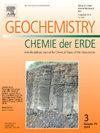Late Neoarchean multi-stage granitoid rocks in the Dengfeng terrane, North China Craton: Petrogenesis and implications for geodynamic processes
IF 2.9
3区 地球科学
Q2 GEOCHEMISTRY & GEOPHYSICS
引用次数: 0
Abstract
During the late Neoarchean era, the rise of K-rich granitoid rocks marked a significant geological event indicative of the maturation and stabilization of continental crust. These granitoids, emerging after tonalite-trondhjemite-granodiorite (TTG) magmatism, stirred debates over the interrelations and geodynamic implications. In this study, diverse granitoid rocks were identified in the Dengfeng terrane of the North China Craton (NCC), dating as approximately 2.63–2.50 Ga. The 2.5 Ga meta-dioritic rocks exhibit elevated MgO (2.2–7.7 wt%) and Mg# (45–69). Geochemical simulation reveals sanukitoid-like pattern, featuring highly fractionated REE compositions and depleted zircon Hf isotopes (ƐHf(t) values range from +3.9 to +6.5). Apatite Nd isotopes of εNd(t) values ranging from −0.1 to 4.69. Meta-dioritic rocks were interpreted to be formed by partial melting of a depleted mantle source influenced by subducted slab-derived fluids. The TTG gneiss (2.63–2.52 Ga) exhibit mildly fractionated REE patterns, weakly positive Eu anomalies, lack of magmatic fractionation evidence, and high (La/Yb)N (6.94–114.9) and Sr/Y (28.6–294) ratios, indicating their formation derived from partial melting of pre-existing low-K mafic crust. The K-rich granitoids (2.56 Ga) are characterized by high K2O/Na2O ratios (0.67–1.89), low MgO content and Mg# (< 1.2 wt% and < 55, respectively). A chain of evidence including geochemical modeling, constant aluminum saturation index (ASI) values of 1.00–1.35, and zircon εHf(t) values ranging from +8.2 to +11.2 suggest their derivation through partial melting of tonalitic rocks. Further analysis suggests that the source for K-rich granitoids are enriched by subducted slab melts or metasedimentary rocks at various crustal depths. In terms of petrogenesis, late Neoarchean granitoid magmatism in Dengfeng terrane likely relates to subduction and accretionary orogeny. Archean active continental margins are vital for early crustal maturation and granitoid diversification during subduction and collision.

华北克拉通登封地体新太古代晚期多期花岗岩:岩石成因及其地球动力学意义
新太古代晚期富钾花岗质岩石的崛起标志着大陆地壳成熟稳定的重大地质事件。这些花岗岩是在闪长花岗岩(TTG)岩浆作用之后出现的,它们之间的相互关系和地球动力学意义引起了争论。在华北克拉通登封地体中发现了多种花岗岩类岩石,其年代约为2.63 ~ 2.50 Ga。2.5 Ga变质闪长岩的MgO (2.2 ~ 7.7 wt%)和Mg#(45 ~ 69)显著升高。地球化学模拟结果显示,稀土元素组成呈sanukitoidi型,稀土元素组成呈高度分异,锆石Hf同位素呈贫态(ƐHf(t)值在+3.9 ~ +6.5之间)。磷灰石Nd同位素εNd(t)值为−0.1 ~ 4.69。变闪长岩被解释为受俯冲的板块衍生流体影响的衰竭地幔源的部分熔融形成。TTG片麻岩(2.63 ~ 2.52 Ga)表现出轻度REE分异模式,弱Eu正异常,缺乏岩浆分异证据,La/Yb N(6.94 ~ 114.9)和Sr/Y(28.6 ~ 294)比值高,表明其形成源于原有低钾基性地壳的部分熔融。富钾花岗岩(2.56 Ga)具有K2O/Na2O比值高(0.67 ~ 1.89)、MgO含量低、Mg# (<;1.2 wt%和<;分别为55)。地球化学模拟、恒定铝饱和度指数(ASI)值在1.00 ~ 1.35之间、锆石εHf(t)值在+8.2 ~ +11.2之间等一系列证据表明,它们是由调性岩石部分熔融形成的。进一步分析表明,富钾花岗岩类的来源是俯冲的板块熔体或不同地壳深度的变质沉积岩。在岩石成因方面,登封地体晚新太古代花岗岩类岩浆活动可能与俯冲和增生造山作用有关。太古宙活动大陆边缘对俯冲和碰撞过程中地壳的早期成熟和花岗质多样化至关重要。
本文章由计算机程序翻译,如有差异,请以英文原文为准。
求助全文
约1分钟内获得全文
求助全文
来源期刊

Chemie Der Erde-Geochemistry
地学-地球化学与地球物理
CiteScore
7.10
自引率
0.00%
发文量
40
审稿时长
3.0 months
期刊介绍:
GEOCHEMISTRY was founded as Chemie der Erde 1914 in Jena, and, hence, is one of the oldest journals for geochemistry-related topics.
GEOCHEMISTRY (formerly Chemie der Erde / Geochemistry) publishes original research papers, short communications, reviews of selected topics, and high-class invited review articles addressed at broad geosciences audience. Publications dealing with interdisciplinary questions are particularly welcome. Young scientists are especially encouraged to submit their work. Contributions will be published exclusively in English. The journal, through very personalized consultation and its worldwide distribution, offers entry into the world of international scientific communication, and promotes interdisciplinary discussion on chemical problems in a broad spectrum of geosciences.
The following topics are covered by the expertise of the members of the editorial board (see below):
-cosmochemistry, meteoritics-
igneous, metamorphic, and sedimentary petrology-
volcanology-
low & high temperature geochemistry-
experimental - theoretical - field related studies-
mineralogy - crystallography-
environmental geosciences-
archaeometry
 求助内容:
求助内容: 应助结果提醒方式:
应助结果提醒方式:


